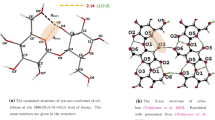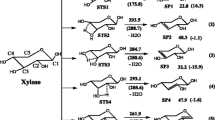Abstract
B3LYP/6–311++G** with dispersion correction (DFT-D) was used to study local and global minimum energy structures of water (H2O) or carbon dioxide (CO2) bonding with a pair of cellobiose molecules. The calculations showed that neither the H2O nor the CO2 prefer to be between the cellobiose molecules, and that the minimum energy structures occur when these molecules bond to the outer surface of the cellobiose pair. The calculations also showed that the low energy structures have a larger number of inter-cellobiose hydrogen bonds than the high energy structures. These results indicate that penetration of H2O or CO2 between adjacent cellobiose pairs, which would assist steam or supercritical CO2 (SC-CO2) explosion of cellulose, is not energetically favored. Comparison of the energies obtained with DFT-D and DFT (the same method but without dispersion correction) show that both hydrogen bonds and van der Waals interactions play an important role in cellobiose-cellobiose interactions.





Similar content being viewed by others
References
Zhang Q, Bulone V, Ågren H, Tu Y (2011) A molecular dynamics study of the thermal response of crystalline cellulose Iβ. Cellulose 18:207–221
Wyman CE (2007) What is (and is not) vital to advancing cellulosic ethanol. Trends Biotechnol 25:153–157
Taherzadeh MJ, Karimi K (2008) Pretreatment of lignocellulosic wastes to improve ethanol and biogas production: a review. Int J Mol Sci 9:1621–1651
Fan LT, Lee Y, Beardmore DH (1980) Mechanism of the enzymatic hydrolysis of cellulose: effects of major structural features of cellulose on enzymatic hydrolysis. Biotechnol Bioeng 22:177–199
Wyman CE (1996) 1: Ethanol production from lignocellulosic biomass: overview. In: Wyman CE (ed) Handbook on bioethanol: production and utilization. Taylor and Francis, Washington, pp 1–18
Mason W H (1926) Process and apparatus for disintegration of wood and the like. US Pat. 1578609
Babcock L W (1932) Method of producing fermentable sugars and alcohol from wood. US Pat. 1855464
Dahman Y, Volynets B (2011) Assessment of pretreatments and enzymatic hydrolysis of wheat straw as a sugar source for bioprocess industry. Int J Energy Environ (IJEE) 2:427–446
Martin-Sampedro R, Rojas OJ, Capanema EA, Hoeger I, Villar JC (2011) Lignin changes after steam explosion and laccase-mediator treatment of eucalyptus wood chips. J Agric Food Chem 59:8761–8769
Jedvert K, Theliander H, Saltberg A, Lindström ME (2012) Mild steam explosion and chemical pre-treatment of Norway spruce. Bio Resources 7:2051–2074
Chacha N, Toven K, Mtui G, Katima J, Mrema G (2011) Steam pretreatment of pine (Pinus patula) wood residue for the production of reducing sugars. Cellul Chem Technol 45:495–501
Kumar P, Barrett DM, Delwiche MJ, Stroeve P (2009) Methods for pretreatment of lignocellulosic biomass for efficient hydrolysis and biofuel production. Ind Eng Chem Res 48:3713–3729
Zheng Y, Lin HM, Wen J, Cao N, Yu X, Tsao GT (1995) Supercritical carbon dioxide explosion as a pretreatment for cellulose hydrolysis. Biotechnol Lett 17:845–850
Zheng Y, Tsao GT (1996) Avisel hydrolysis by cellulose enzyme in supercritical CO2. Biotechnol Lett 18:451–454
Zheng Y, Lin H, Tsao GT (1998) Pretreatment for cellulose hydrolysis by carbon dioxide explosion. Biotechnol Prog 14:890–896
Narayanaswamya N, Faik A, Goetz DJ, Gu T (2011) Supercritical carbon dioxide pretreatment of corn stover and switchgrass for lignocellulosic ethanol production. Bioresour Technol 102:6995–7000
Alinia R, Zabihi S, Esmaeilzadeh F, Kalajahi F (2010) Pretreatment of wheat straw by supercritical CO2 and its enzymatic hydrolysis for sugar production. J Biosystems Eng 107:61–66
Muratov G, Kim C (2002) Enzymatic hydrolysis of cotton fibers in supercritical CO2. Biotechnol Bioprocess Eng 7:85–88
Gua T, Held MA, Faikc A (2013) Supercritical CO2 and ionic liquids for the pretreatment of lignocellulosic biomass in bioethanol production Environ. Technol 34:1735–1749
Stortz CA, Johnson GP, French AD, Csonka GI (2009) Comparison of different force fields for the study of disaccharides. J Carbohydr Res 344:2217–2228
Bergenstråhle M, Matthews J, Crowley M, Brady J (2010) Cellulose crystal structure and force fields. International Conference on Nanotechnology for the forest products industry. Otaniemi, Espoo, Finland
Payal RS, Bharath R, Periyasamy G, Balasubramanian S (2012) Density functional theory investigations on the structure and dissolution mechanisms for cellobiose and xylan in an ionic liquid: gas phase and cluster calculations. J Phys Chem B 116:833–840
Momany FA, Schnupf U (2011) DFTMD studies of β-cellobiose: conformational preference using implicit solvent. Carbohydr Res 346:619–630
French AD, Johnson GP (2006) Quantum mechanics studies of cellobiose conformations. Can J Chem 84:603–612
French AD, Johnson GP (2008) Roles of starting geometries in quantum mechanics studies of cellobiose. Mol Simul 34:365–372
Bazooyar F, Taherzadeh M, Niklasson C, Bolton K (2013) Molecular modelling of cellulose dissolution. J Comput Theor Nanosc 10:2639–2646
Bazooyar F, Momany FA, Bolton K (2012) Validating empirical force fields for molecular-level simulation of cellulose dissolution. Comput Theor Chem 984:119–127
Strati GL, Willett JL, Momany FA (2002) Ab initio computational study of β-cellobiose conformers using B3LYP/6-311++ G**. Carbohydr Res 337:1833–1849
Strati GL, Willett JL, Momany FA (2002) A DFT/ab initio study of hydrogen bonding and conformational preference in model cellobiose analogs using B3LYP/6-311++ G**. Carbohydr Res 337:1851–1859
Bosma WB, Appell M, Willett JL, Momany FA (2006) Stepwise hydration of cellobiose by DFT methods: 2. Energy contributions to relative stabilities of cellobiose (H2 O) 1–4 complexes. THEOCHEM 776:1–19
Momany FA, Willett JL (2000) Computational studies on carbohydrates: I. Density functional ab initio geometry optimization on maltose conformations. J Comput Chem 21:1204–1219
French AD, Johnson GP (2004) Advanced conformational energy surfaces for cellobiose. Cellulose 11:449–462
Aldred P http://www.accelrys.com/resource-center/case-studies /archive /studies /cellulose.html. Accessed 12 April 2014
Bazooyar F, Bolton K (2014) Molecular-level simulations of cellulose steam explosion. Quantum Matter. doi:10.1166/qm.2015.1178
Grimme S (2004) Accurate description of van der Waals complexes by density functional theory including empirical corrections. J Comput Chem 25:1463–1473
Piacenza M, Grimme S (2005) Van der Waals interactions in aromatic systems: structure and energetics of dimers and trimers of pyridine. Chem Phys Chem 6:1554–1558
Grimme S, Antony J, Ehrlich S, Krieg H (2010) A consistent and accurate ab initio parametrization of density functional dispersion correction (DFT-D) for the 94 elements H-Pu. J Chem Phys 132:154104
Grimme S (2006) Semiempirical GGA‐type density functional constructed with a long‐range dispersion correction. J Comput Chem 27:1787–1799
Becke AD (1993) Density‐functional thermochemistry. III. The role of exact exchange. J Chem Phys 98:5648
Lee C, Yang W, Parr RG (1998) Development of the Colle-Salvetti correlation-energy formula into a functional of the electron density. Phys Rev B 37:785–789
Miehlich B, Savin A, Stoll H, Preuss H (1989) Results obtained with the correlation energy density functionals of becke and Lee, Yang and Parr. Chem Phys Lett 157:200–206
Stephens PJ, Devlin FJ, Chabalowski CF, Frisch MJ (1994) Ab initio calculation of vibrational absorption and circular dichroism spectra using density functional force fields. J Phys Chem 98:11623–11627
Lii JH, Ma B, Allinger NL (1999) Importance of selecting proper basis set in quantum mechanical studies of potential energy surfaces of carbohydrates. J Comput Chem 20:1593–1603
Schmidt MW, Baldridge KK, Boatz JA, Elbert ST, Gordon MS, Jensen JH, Matsunaga N, Koseki S, Nguyen KA, Su SJ, Windus TL, Dupuis M, Montgomery JA (1993) General atomic and molecular electronic structure system. J Comput Chem 14:1347–1363
Sun H (1998) COMPASS: an ab initio force-field optimized for condensed-phase applications overview with details on alkane and benzene compounds. J Phys Chem B 102:7338–7364
Bunte SW, Sun H (2000) Molecular modeling of energetic materials: the parameterization and validation of nitrate esters in the COMPASS force field. J Phys Chem B 104:2477–2489
Sarko A, Muggli R (1974) Packing analysis of carbohydrates and polysaccharides. III. Valonia cellulose and cellulose II. Macromolecules 7:486–494
Wu X, Wagner R, Raman A, Moon R, Martini A (2010) Elastic deformation mechanics of cellulose nanocrystals. Miner, Met Mater Soc (TMS) 2:689–695
Wu X, Moon R, Martini A (2011) Calculation of single chain cellulose elasticity using fully atomistic modelling. Tech Assoc Pulp Paper Indust J (TAPPI J) 10:37–43
Miyamoto H, Umemura M, Aoyagi T, Yamane C, Ueda K, Takahashi K (2009) Structural reorganization of molecular sheets derived from cellulose II by molecular dynamics simulations. Carbohydr Res 344:1085–1094
Miyamoto H, Yamane C, Ueda K (2013) Structural changes in the molecular sheets along (hk0) planes derived from cellulose Iβ by molecular dynamics simulations. Cellulose 20:1089–1098
Eichhorn SJ, Davies GR (2006) Modelling the crystalline deformation of native and regenerated cellulose. Cellulose 13:291–307
Bolton K, Nordholm S (1994) An evaluation of the Gauss-Radau algorithm for the simulation of chemical dynamics. J Comput Phys 113:320–335
Fletcher R, Reeves CM (1964) Function minimization by conjugate gradients. Comput J 7:149–154
Ermer O (1976) Calculation of molecular properties using force fields. Applications in organic chemistry. Struct Bond 27:161–211
Levitt M, Lifson S (1969) Refinement of protein conformations using a macromolecular. J Mol Biol 46:269–279
Lalanne P, Tassaing T, Danten Y, Cansell F, Tucker SC, Besnard M (2004) CO2-ethanol interaction studied by vibrational spectroscopy in supercritical CO2. J Phys Chem A 108:2617–2624
Acknowledgments
Financial support from Stiftelsen Föreningssparbanken Sjuhärad and The Carl Trygger Foundation for Scientific Research is gratefully acknowledged. GAMESS-US, version 1 OCT 2010 (R1) was used at the high performance computer cluster Kalkyl at UPPMAX (Uppsala Multidisciplinary Centre for Advanced Computational Science), Uppsala Sweden. Calculations using the COMPASS force field were done using the program from Accelrys Software Inc.
Author information
Authors and Affiliations
Corresponding author
Rights and permissions
About this article
Cite this article
Bazooyar, F., Bohlén, M. & Bolton, K. Computational studies of water and carbon dioxide interactions with cellobiose. J Mol Model 21, 16 (2015). https://doi.org/10.1007/s00894-014-2553-5
Received:
Accepted:
Published:
DOI: https://doi.org/10.1007/s00894-014-2553-5




